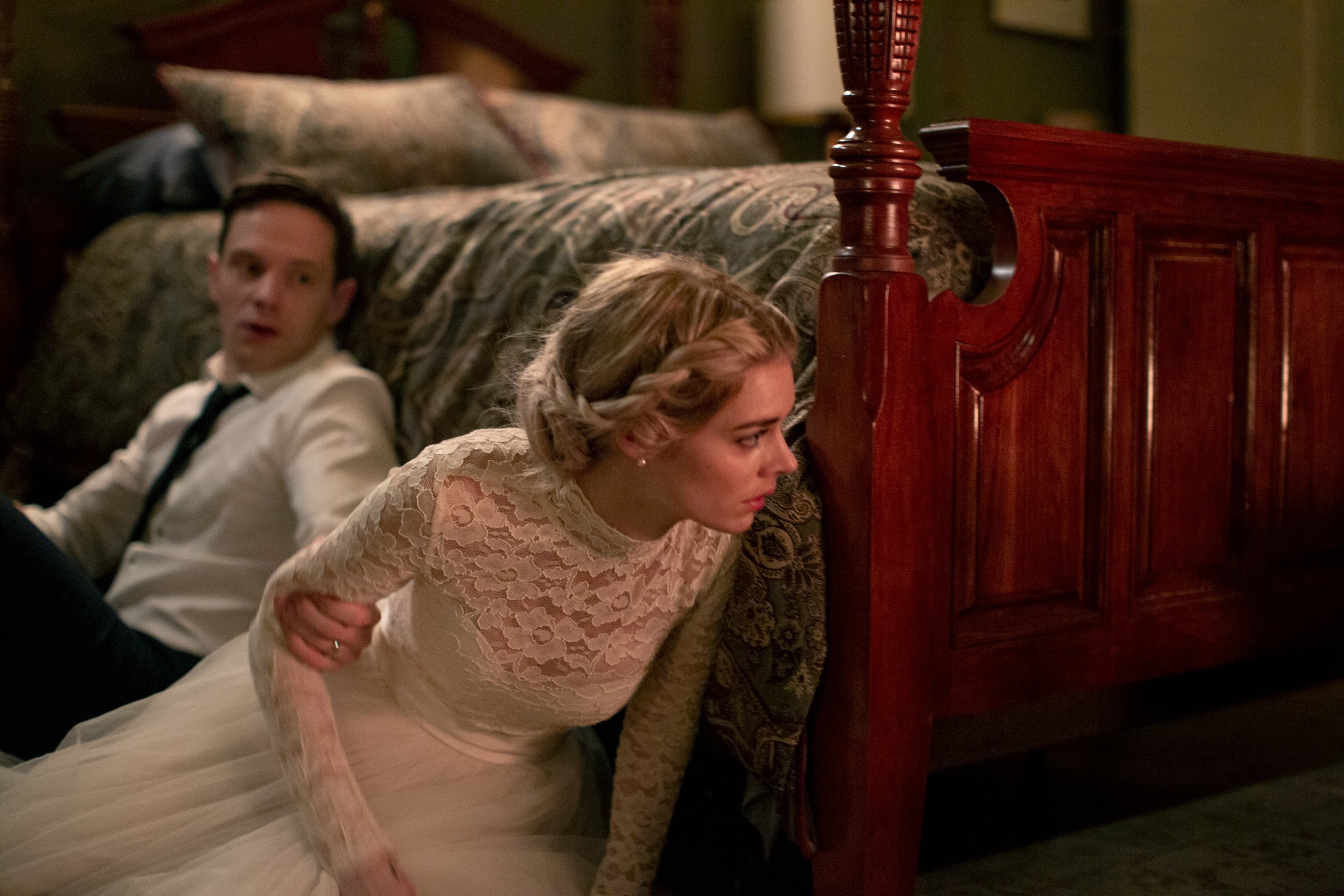Table of Contents Show
It is hard to find someone who feels ambivalent about horror; some adore it, and some loathe it — rarely can you find someone who falls into a middle ground. Yet, in reality, few genres hold as much nuance as a socially charged horror film. Yes, plenty of horror falls victim to playing into stereotypes and producing mindless entertainment, but equally so can one find horror with pertinent themes and subversive plots. One film, in particular, that highlights this notion is the 2019 slasher, Ready or Not (Matt Bettinelli-Olpin and Tyler Gillett), which showcases a deconstruction of the idealized bride in Western society through the symbolic ruining of the bride’s wedding dress.
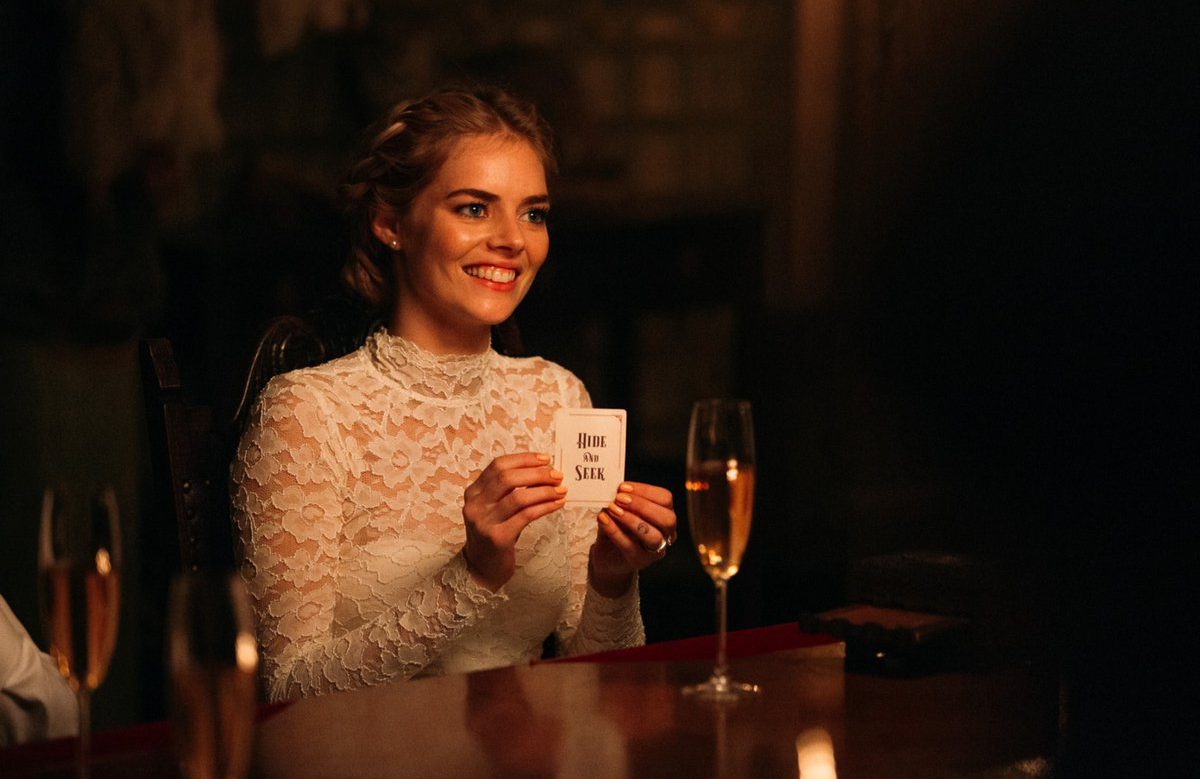
Following Grace, the plucky protagonist played by Samara Weaving, on the day of her wedding, Ready or Not shows a joyous day turning sinister when the bride’s eccentric in-laws force her to partake in an unusual tradition. The wealthy Le Domas family that Grace has newly married into accrued their fortune by creating their own spot within the board game industry. So, to honor new spouses into the family, the latest addition must randomly select a card stating what game the family must partake in from an heirloom box. Grace’s celebratory day then turns into a fight for her life when she draws the card reading, “Hide and Seek.” It sounds easy enough, albeit this version holds a terrifying twist to the innocuous children’s game — Grace must hide as her new family seeks to kill and sacrifice her before the sun rises.
The Sociopolitical Horror Of Ready Or Not (2019)
The horror genre functions with many sub-genres, and slashers fall right to the bottom of respectable. “Elevated Horror” (a pretentious phrase for calling specific physiological horror films reputable works, as if it needs a term of its own and should not be associated with other works of the genre) and even “glossier satanic films” (( Clover, Carol J. “Her Body, Himself: Gender in the Slasher Film.” Representations, no. 20, Autumn 1987, pp. 187-228. )) have some level of respect in film analysis. However, the slasher film, often focused on overt sexual imagery encased in the taboo, is often dismissed as too much — too cliché, too gory, too sexual (( Williams, Linda. “Film Bodies: Gender, Genre, and Excess.” Film Quarterly, vol. 44, no. 4, Summer 1991, pp. 2-13. )). Yet, horror creates a blurred line forming a connection between one’s real fears and one’s surreal fears. It is within that discomfort, within that excess, the taboos and inner anxieties of the masses are expounded upon.
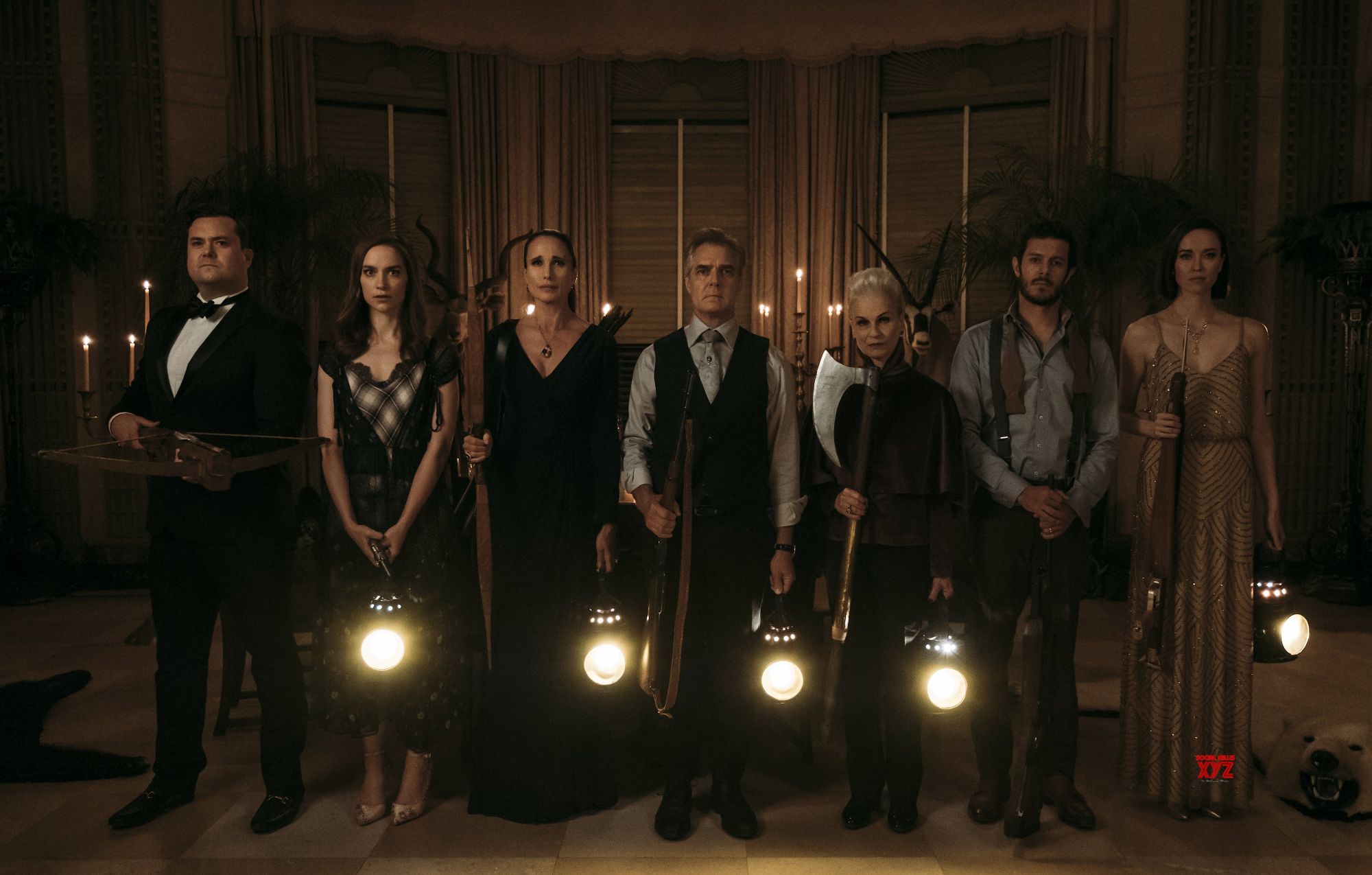
Here is where Ready or Not flourishes. Cultural anxieties and nightmares of the independent bride who cannot assimilate into the family are the, not all that hidden, subtext in this story of hide and seek. On many levels, the world is still terrified of independent women who stray from long-standing traditions and corrupt sons in the process. Ready or Not elaborates on how “women find their own channels of power and what men fear about women and women’s sexuality.” (( King, Stephen. “The Modern American Horror Movie — Text and Subtext.” Danse Macabre. New York, Everest House, 1981. )) It brings this apprehension to the foreground as it constructs a story around the deconstruction of this perfect bride. Thus,
“The image of a woman in her wedding dress hunted by her husband’s family evokes a strong feminist metaphor as marriage often acts as a synecdoche for the institution of patriarchy.”
(( Dulabaum, Madeline. “Ready or Not: Here Come the Feminists.” Ragazine, Accessed 16, December 2021. ))
Instead, being a passive player in this family’s twisted tradition, Grace actively contests against her expected role, contrasting the glorified fantasy of the ideal bride. The transformation of her dress aids to support this notion, acting as a symbolic dismantlement for her resistance to the role of the conventional bride as submissive.
A Subversive Final Girl
Grace is a refreshing subversion of the final girl trope. A term coined by Carol J. Clover, the final girl, describes the last-woman-standing in a horror film, particularly that of a slasher (( Clover, Carol J. “Her Body, Himself: Gender in the Slasher Film.” Representations, no. 20, Autumn 1987, pp. 187-228. )). Sole survivor of the slashing, she is the one who endures the horrors upon her mind and body to defeat the villain. The traditional execution of this trope positions this character as different, distinguished by her looks, intellect, and lack of sexual promiscuity in contrast to her friends. Ready or Not presents Grace amongst a relativized breed of final girls. She completely upends these ideals of what a final girl should be as, from the start of the film, she has always been the only intended victim and is no blushing bride, faking a façade of virtue. She is resourceful and quick-thinking, open about her sexual promiscuity and indulgence in her vices.
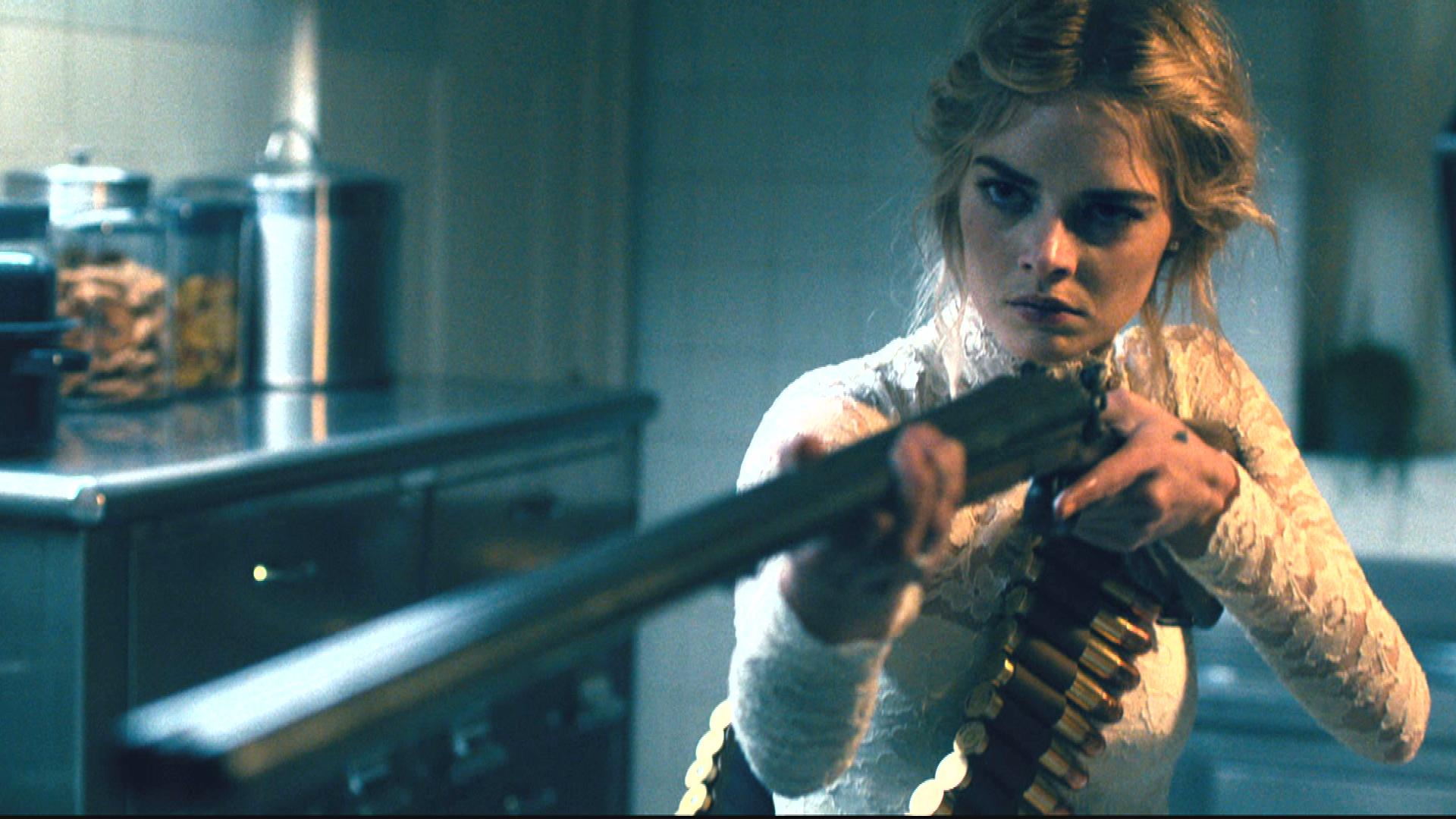
In fact, the first time the viewer lays eyes upon Grace is when she is sitting in front of a mirror, clad in her lacy, long-sleeved wedding gown, and reciting her vows. For a moment, she is the epitome of the idealized Western bride, a model of classic formality. Grace breaks from this mold only a few minutes into the film when she pulls out a cigarette and begins to smoke. While Grace’s positionality is different from that of a final girl in an 80s slasher, her fate as one remains the same: continually escape the killer long enough to be rescued or to kill the villain herself.
The Symbolic Ruining Of Grace’s Gown
Symbolizing tradition, Grace’s dress—long-sleeved and lacy with an accompanying veil—holds so much transformation throughout the film that it becomes the principal device to understanding Grace’s metamorphosis. Codes of a film, following the theory of semiotics, are used to subtly reinforce ideas for the audience. “The term semiotics means theory of signs…the semiotics of the cinema is, similarly, the theory of film-as-as-system-of-signs.” (( Harman, Gilbert. “Semiotics and the Cinema: Metz and Wollen.” Film Theory & Criticism. New York, Oxford University Press, 2019. )) When a character wears a mask, they are hiding something. When a jealous character is dressed in green, it reinforces their envy. Shaped by the culture, one lives in, signs have been programmed into one’s subconscious since a young age. Film takes these established codes and uses them to reinforce how certain characters should be perceived. In the case of Ready or Not, the audience watches a wedding dress, a symbol of unattainable purity, turn into a blood-sodden mess of lace and tulle, illustrating Grace breaking such a traditional mold.
From The Woman In White To The Woman In Red
As the night goes on, Grace’s dress becomes ripped, torn, and splattered with blood. This results in a complete alteration of the gown, much of which is a side effect of the physical distress she has been put through. The bride’s wedding dress — white, laced, and modest — acts as a metaphor for the detriment of patriarchal roles as the film continues. Ready or Not is unashamedly in-your-face obvious about the transformation that takes place in the plot and in the appearance of Grace. She is both physically and metaphorically unraveling her idealized self through the ruining of her own gown. Early in the film, it is made known that Grace is a foster child and holds a strong desire to belong to a new family. As a result, she is eager to join her fiancé. Once a symbol for the idealized purity of Grace working to impress her peculiar in-laws, the dress follows a transformation of a woman doing whatever it takes to please her new family to doing whatever it takes to fight for her life.
At the first rip, a snag on a dumbwaiter, Grace swears at the tear in her gown. Then, hiding in there and waiting to be “seeked,” she crawls out, declaring her boredom and wondering how this could possibly be the way she is spending her wedding night. It is important to note that she plays along because of her desire to assimilate into the family. Yet, as the narrative progresses, she tears the dress without hesitating, weaponizes it, to actively fight against the very people she was trying so eagerly to gain approval from.
The Phases Of The Dress
Following three phases that showcase the different stages of the film and, simultaneously, Grace’s character development, her wedding gown acts as a symbolic device to communicate this transformation to the viewer. As mentioned, the first shot of Grace shows her as a pristine bride, like one plucked directly out of a bridal magazine. Grace’s dress was even inspired by Kate Middleton’s and Grace Kelly’s wedding gowns. Before she realizes the Le Domas family’s horrifying end goal, ripping her wedding dress was still the biggest horror of the night to the bride. Unfortunately for her, that was only the beginning of the end.
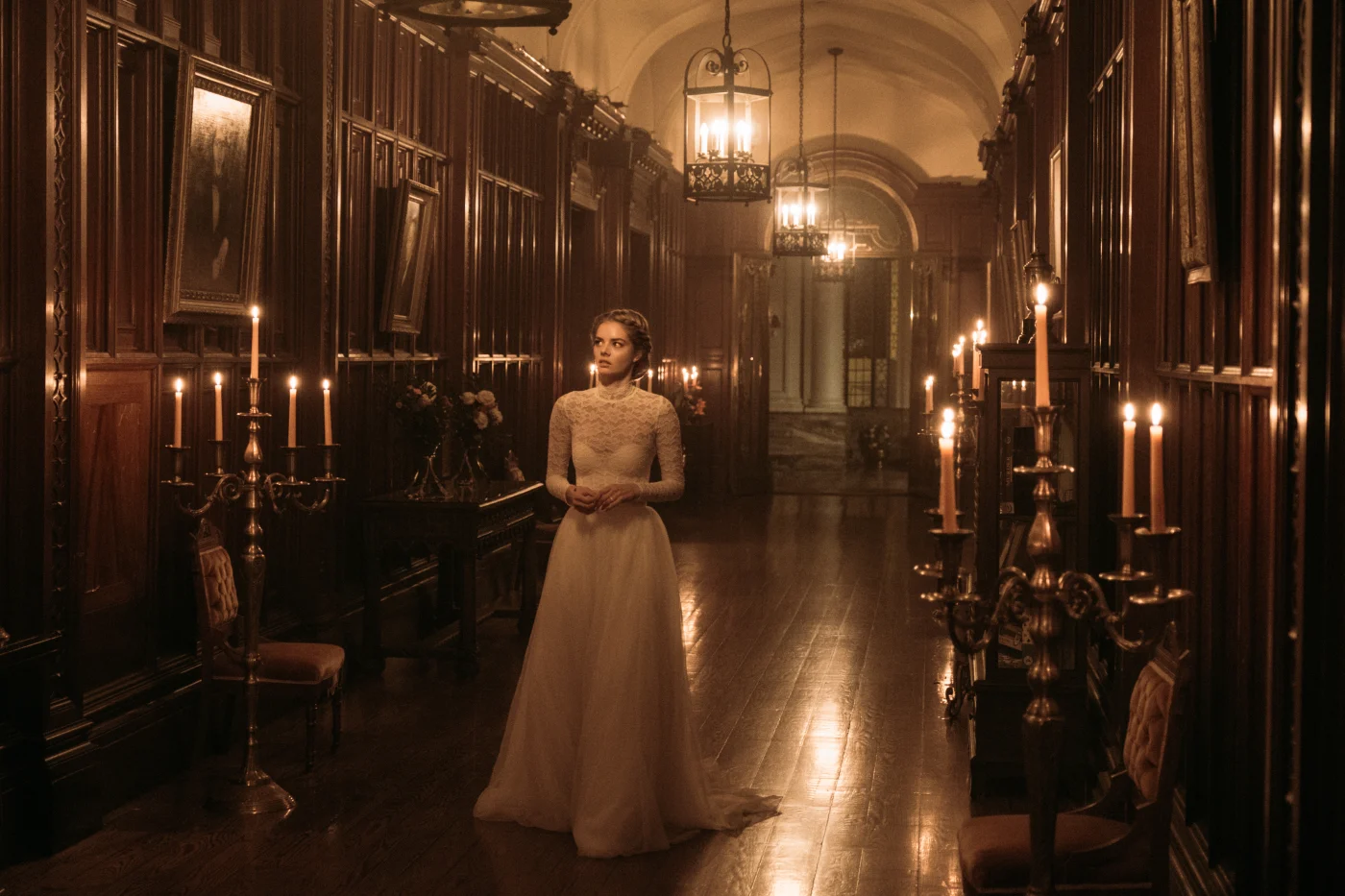
Phase One
After witnessing a member of the Le Domas family kill one of their maids, Grace is struck with a wave of panic. Her newly-wedded husband tries to bolster her as he plans their escape, prepping his wife on how to exit the mansion as he runs to turn off the alarm system. This is when Grace makes the first intended alteration to the her outfit by changing out of her heels and into a pair of beat-up, yellow Converse.
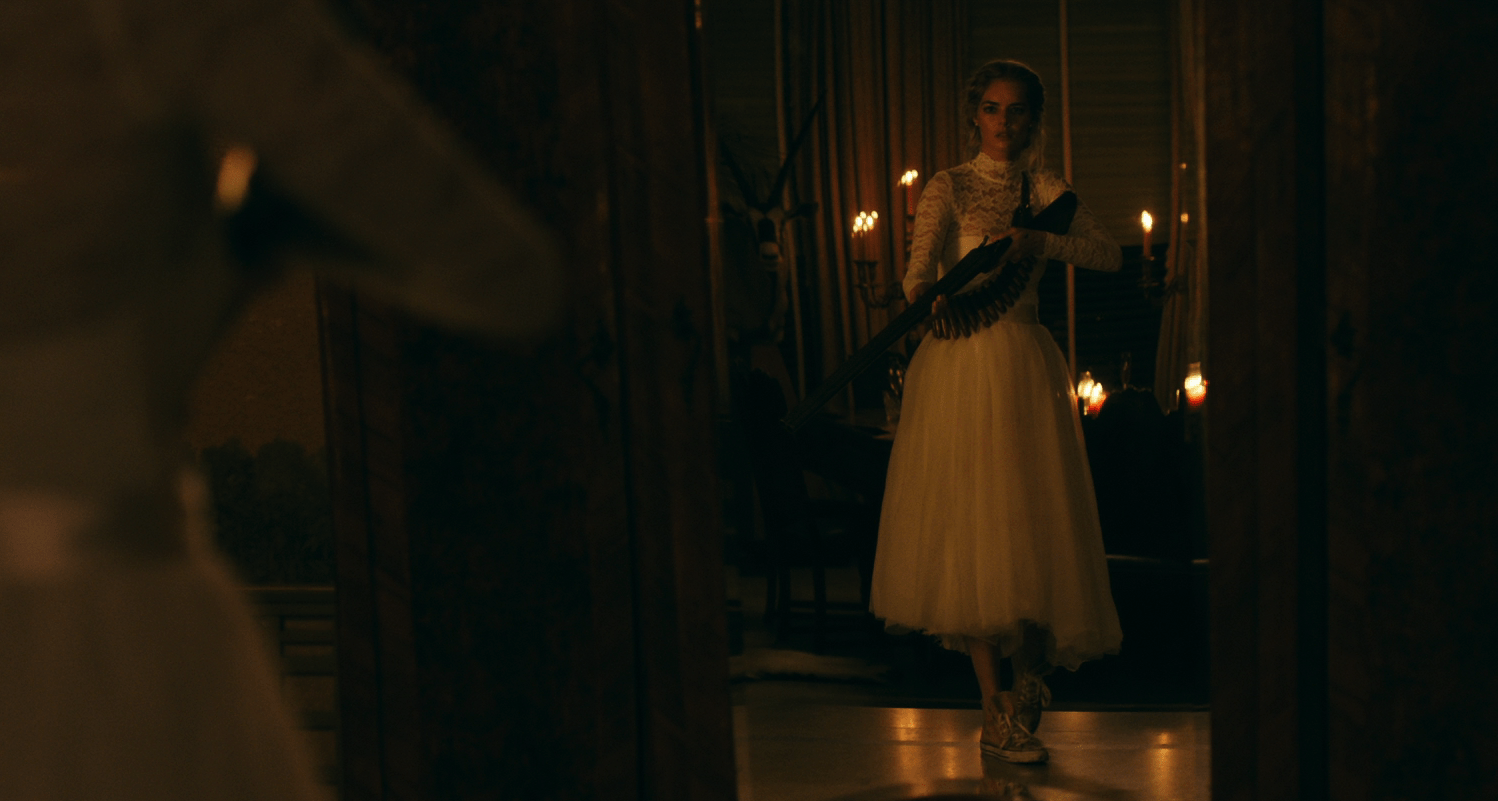
Walking a few steps before realizing the hem of her skirt is too long for a mission like this, she rips the tulle into a shorter, moveable length. And, “now that the dress was shorter, and it was easier to run from her murderous family, things started to get a lot darker. Literally.” (( Snyder, Chris. “How the transforming wedding dress was designed for ‘Ready or Not.‘” Insider, 23 Aug 2019. )) Seconds later, when she spots herself in a mirror, she is taken aback. Breathing out “Jesus” at her own reflection, she vocalizes what the film has the viewer thinking as well. This moment marks a character shift from which Grace is no longer a passive bride playing along to please her new family but a woman with free agency.
Phase Two
After the realization sets in, the film moves into its second stage. Grace, upon making it out of the mansion, stumbles into the family’s stable. Here, she runs into one of the kids who was supposed to be fast-asleep, upstairs. As Grace raises her arm to show she is not a threat, the kids reveal themselves as one and shoot her through the hand. The bride trips and falls into a cellar filled with flies and decaying goat carcasses at her shock. Her white gown now shifts in appearance from a clean white to an off-white, yellowing color. While this is a continuity of the story’s diegesis, it also illustrates another level of deconstruction. The idea of the pure bride has gone away. Still, in agony, covered in goat guts, Grace rips a sleeve from her dress to bandage her bleeding hand. Metaphorically and literally unraveling with each scene,
“Grace’s dress becomes not only a weapon, but a tool, a first-aid kit, and an emblem of the patriarchy and long-held class codes.”
(( Dulabaum, Madeline. “Ready or Not: Here Come the Feminists.” Ragazine, Accessed 16, December 2021. ))
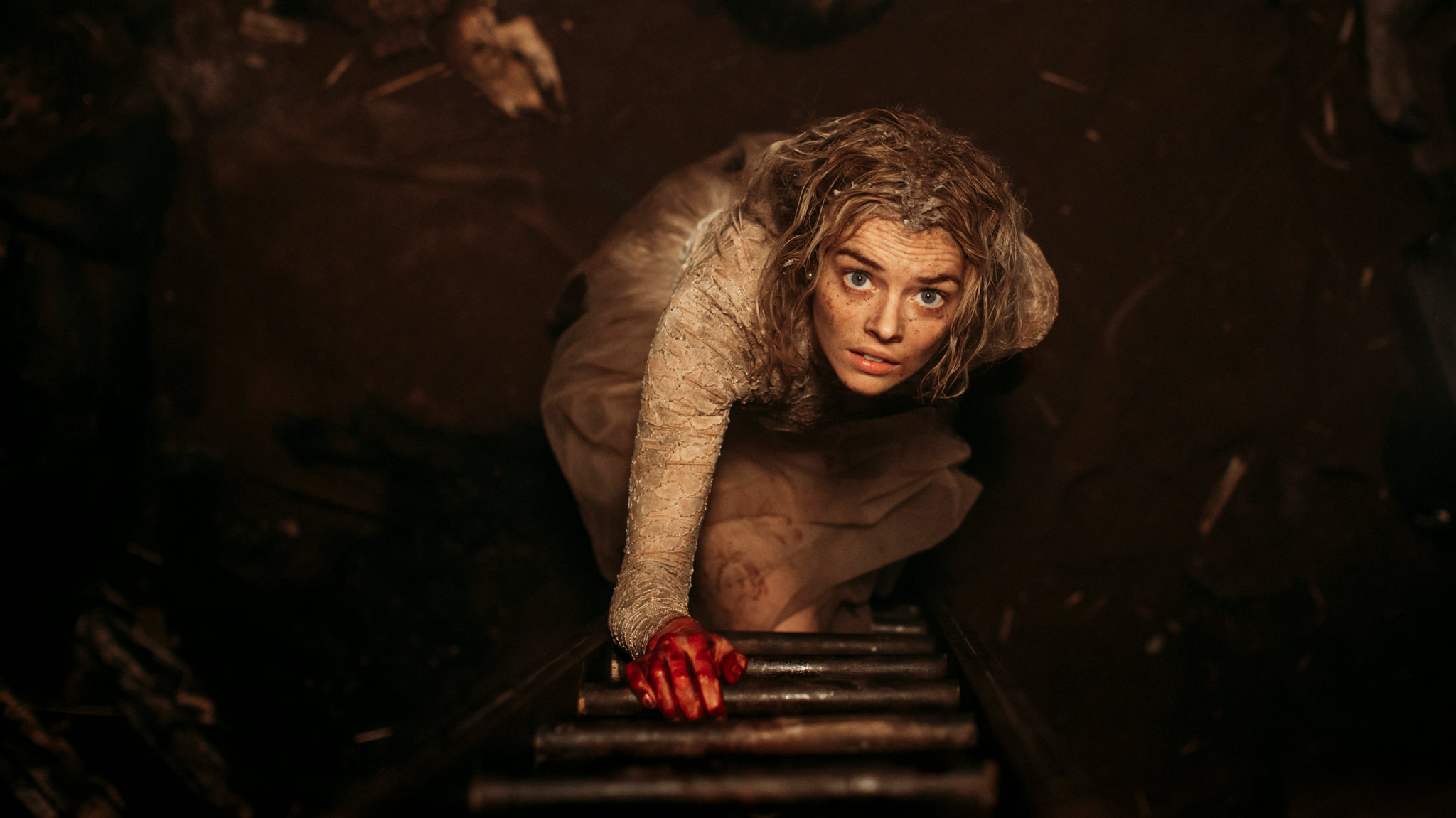
Phase Three
Horror after horror, Grace is forced to deal with unthinkable terrors as she continues to fight for her life. She scratches her back (and more of the gown) as she desperately tries to push her body through the front gates of the Le Domas property. Finally, she removes the sash around her waist to strangle someone. She is no longer paralyzed by fear or falling over her own gown. Now, Grace is able to run, crawl, and defend herself as she fights to make it through the night.
All this gruesome terror stems from the family’s belief that they will die from a familial curse if they cannot accomplish sacrificing Grace before the sun rises. Ready or Not uses horror in many ways, but the principal component of the film is that it capitalizes on is the fear of death and the juxtaposition of beauty around death. After all, “in a society where such a great deal of store is place in the fragile commodities of youth, health, and beauty, death and decay become inevitably horrible, and inevitably taboo.” (( King, Stephen. “The Modern American Horror Movie — Text and Subtext.” Danse Macabre. New York, Everest House, 1981. )) The Le Domas family is hellbent on killing Grace and following through with this delusion because they are so afraid of death, even her husband. Then, Grace becomes their worst nightmare as she vehemently defies their desire and becomes a symbol of everything they fear.
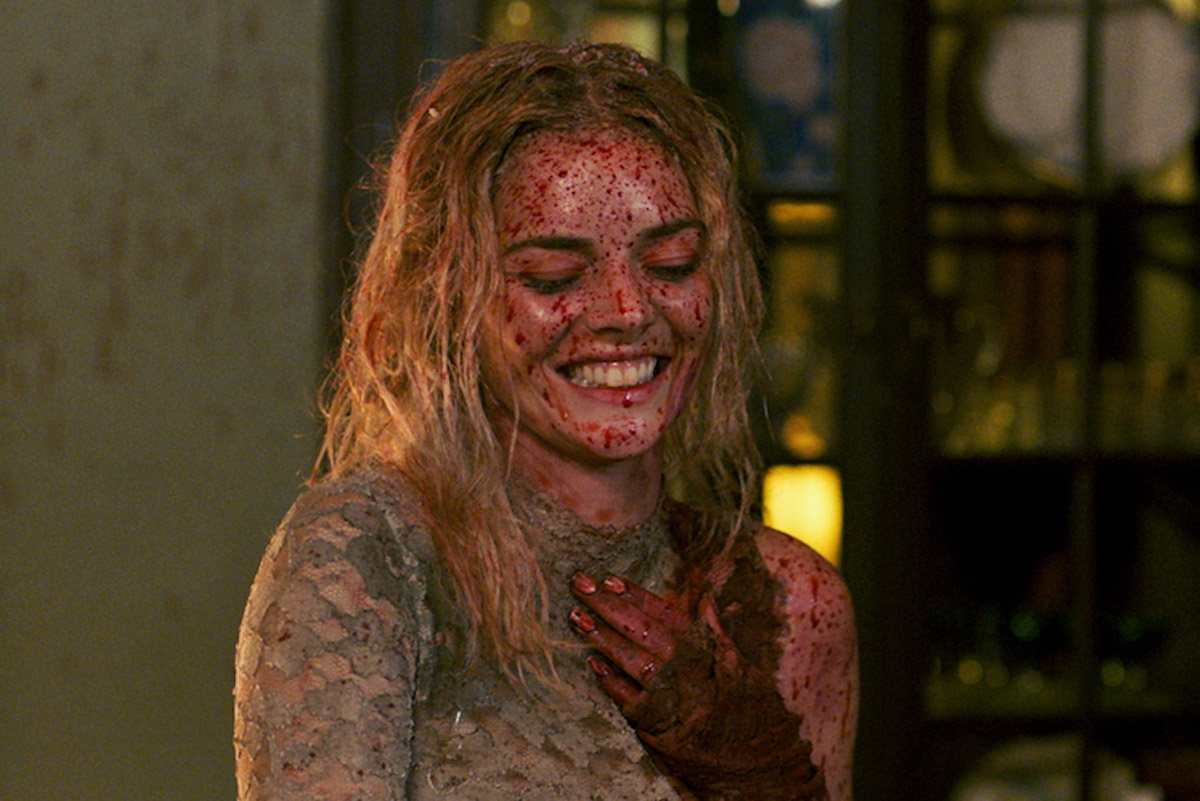
In the final phase of film, the sun begins to rise. Grace has made it until dawn. Bodies piling up, the remaining members of the Le Domas family spontaneously combust in a humorous yet incredibly satisfying moment. Splattering the mansion walls, their guts paint Grace’s already disastrous dress. The symbolic garment is unrecognizable at this point. As the mansion catches on fire, burning the family’s fortune and evidence of what occurred overnight, Grace makes her way out into the daylight. She has won the game by giving a ceremonious sniff to her armpit and lighting up a cigarette. While lighting a cigarette seemed insignificant during the opening scene, this is the act that bookends the film. After she has made it through the night, thoroughly deconstructing her idealized bridal status and sodden in her in-law’s blood, she pulls out a cigarette once again, returning to the first transgression the viewer saw her perform.
Why Does Ready Or Not (2019) Work?
One critic argues:
“There is nothing besides dialogue that indicates Grace is not a born-and-bred member of the upper class. When the movie begins, Grace looks like she belongs at the mansion with her flawless complexion, straight white teeth, and elaborately done-up hair.”
(( Dulabaum, Madeline. “Ready or Not: Here Come the Feminists.” Ragazine, Accessed 16, December 2021. ))
However, this depiction of integrated ease works to stress both: (a) Grace’s transformation and (b) the expectations of the idealized bride meant to assimilate into her new family. If Grace did not appear as if she could belong within the Le Domas family, the deconstruction of her character would not be as astonishingly persuasive.
In the case of Ready or Not, the fear and desire are to belong and have a family. Everyone wants to believe they will fit and feel welcomed into the family of their significant other’s. That is why Grace tries so hard to play her part. Nonetheless, by the end of the film, Grace is a changed woman. Successfully escaping the entrapment of the familial home, Grace’s “desire to survive has triumphed over her desire for a patriarchal family, and the coast of belonging is too high.” (( Dulabaum, Madeline. “Ready or Not: Here Come the Feminists.” Ragazine, Accessed 16, December 2021. )) Tugging off her ring and throwing it in her husband’s face, Grace deadpans that she wants a divorce just as he explodes into a gooey mess of guts, following the rest of his family. A big, metaphorical middle finger to the family and patriarchy, here, she renounces both.
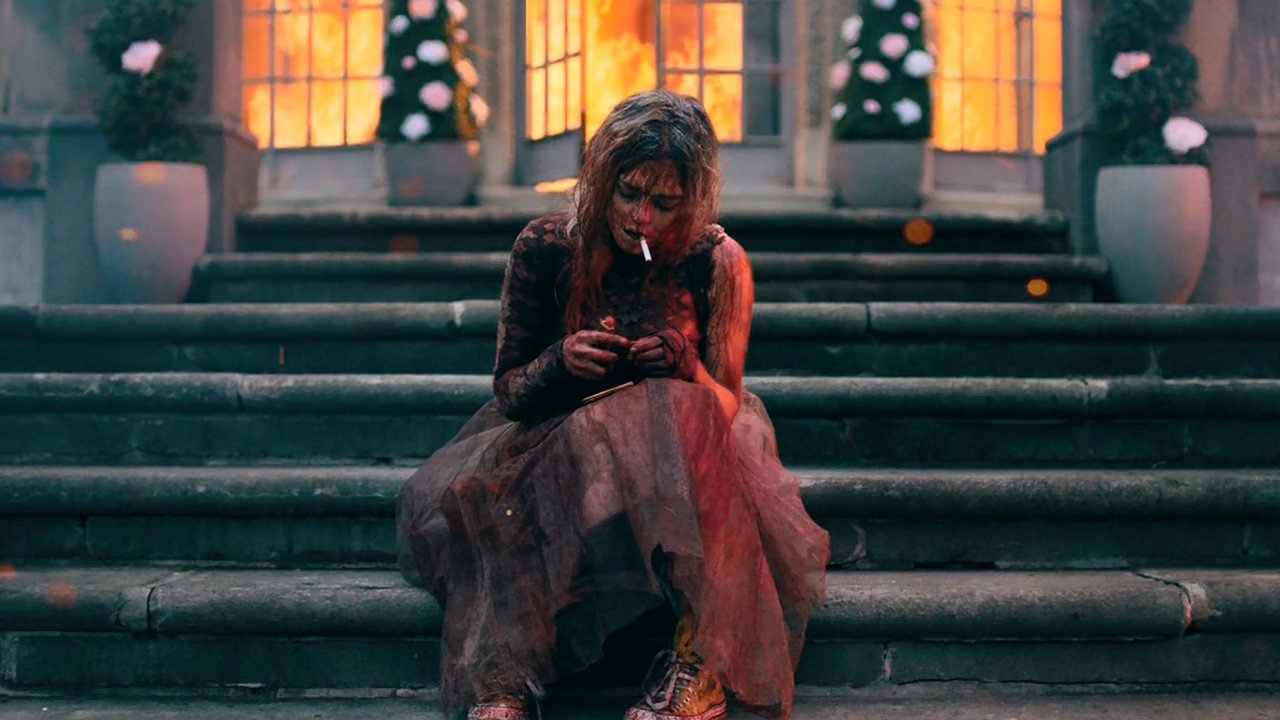
Ready or Not is a divisive film, and not everyone will be along for the ride. But, those that do will find themselves snagged in a compelling story with profound commentary on gender roles and social status. Subverting the concept of what a final girl should be, as well as the romanticized ideal of the submissive bride, every rip and stain to Grace’s wedding dress shows how she has disrupted the status quo.
Ready or not, here comes the bride.
